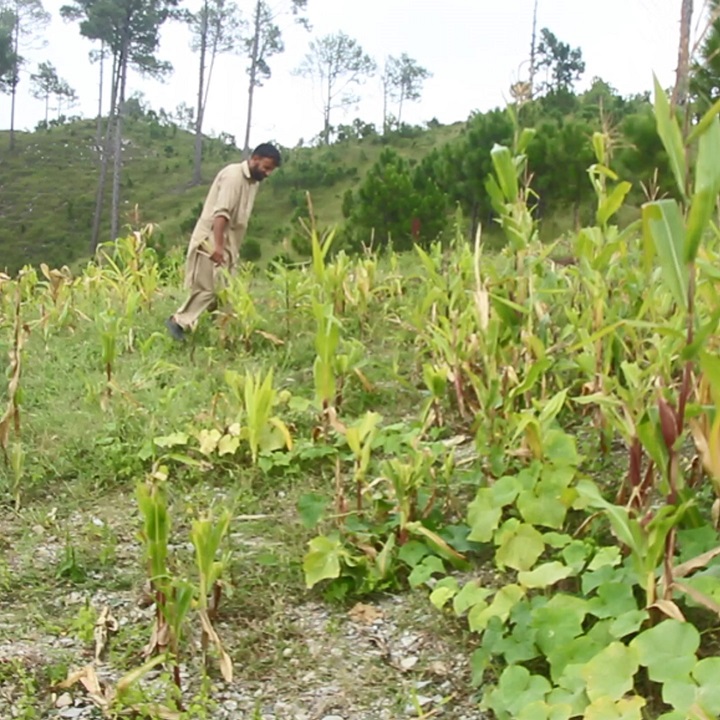In a world where climatic change has taken centre stage, the effects of these changes are also significantly impacting the region of Azad Kashmir under Pakistan’s administration, mainly posing challenges for local farmers.
Muhammad Shakoor, a resident of the village of Thor, located approximately two hours south of Muzaffarabad in the Muzaffarabad district, having a population of two thousand people, relies solely on farming as his source of livelihood. However, due to changing weather patterns, a decline in crop yields has made it increasingly difficult for him to sustain his income from his land.
He says there was no rain for three months the last time he sowed his crops. Following this dry spell, torrential rains arrived with such intensity that land erosion began.
“The agricultural land, which was already limited, has further reduced productivity, affecting our crops. We depend on this land, and after three months of hard work, we used to have enough produce not only for home consumption but also to sell a portion of the harvest to meet our household needs. However, this is no longer possible.”
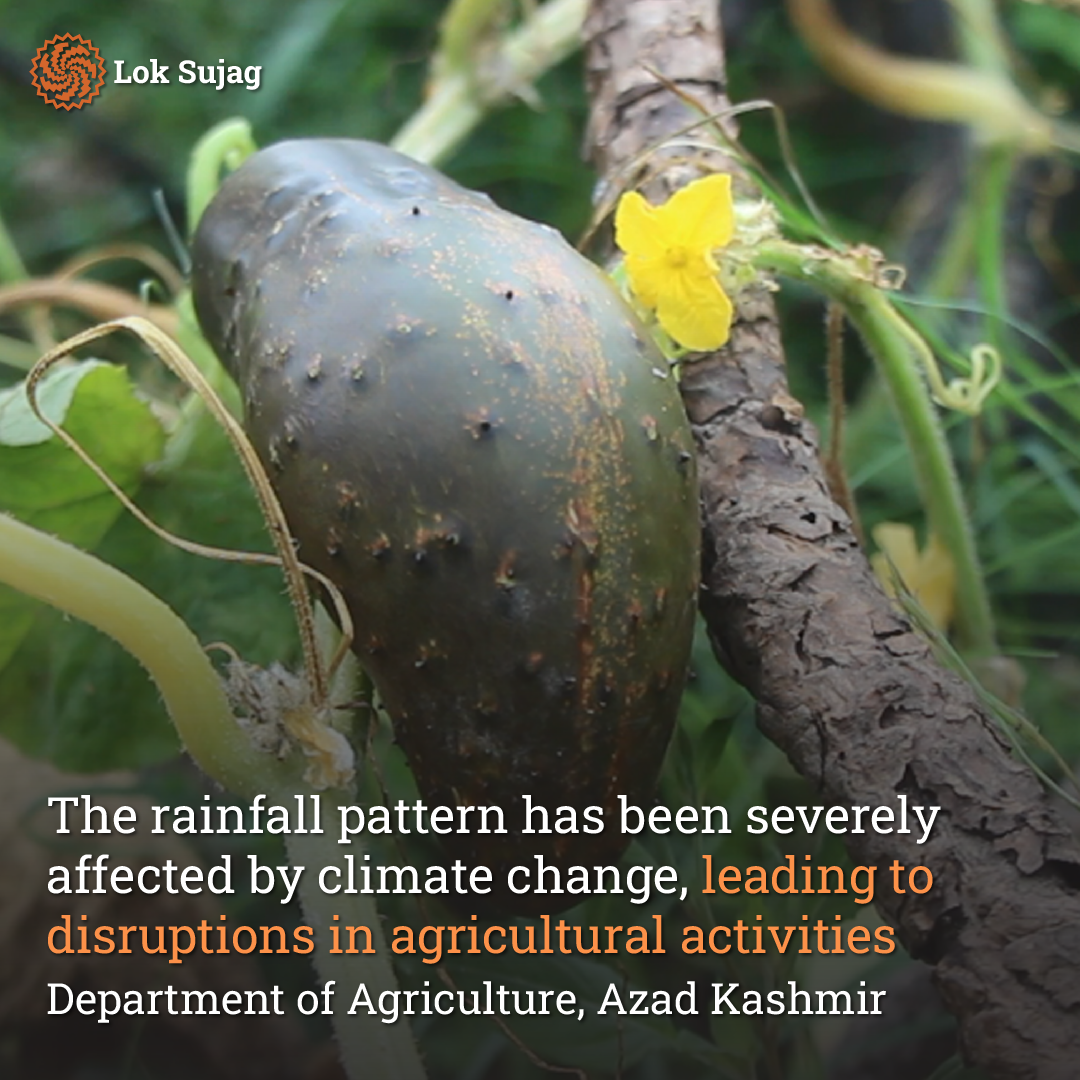
Shazia Kanwal hails from the Leswa area of Neelum Valley. Her husband died in a flood some time ago, during which the deluge also swept away their house and agricultural land. Consequently, their family’s sole source of income vanished, and now she struggles to make ends meet with her five children.
When asked about providing alternative land or financial assistance from the government and relevant authorities, she stated that the government provided them with only 1.5 lakh rupees, which was insufficient to purchase land and build a house.
She has set up a tent on the land of her relatives, where she lives with her children. Since there is a seasonal stream passing near this place, she is concerned about the safety of her children. Due to the unavailability of an alternative place, she is forced to stay there.
Shazia mentions that she had heard that the Saudi government had assisted the affected people of Leswa in providing alternative land and constructing a residential colony. However, she has no information on what happened to that assistance.
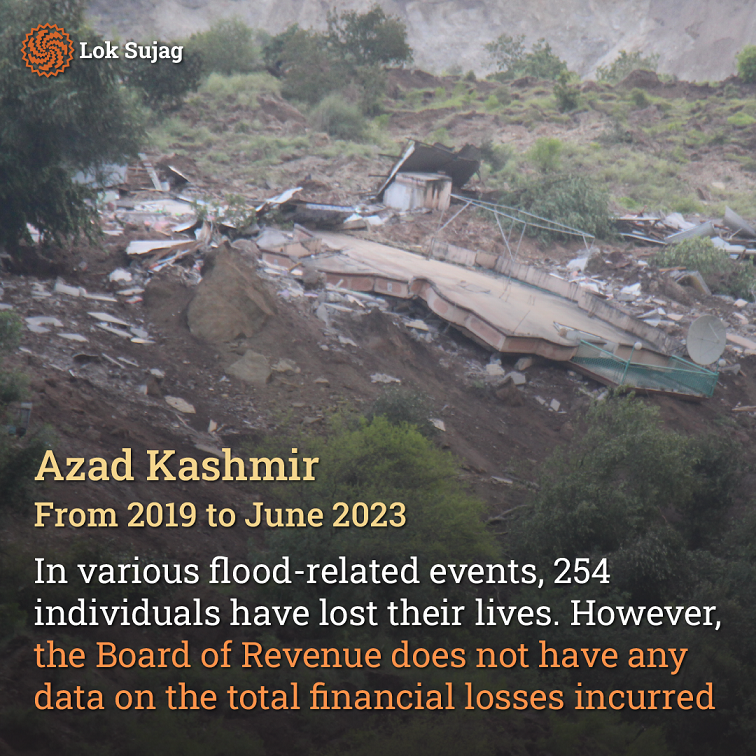
According to the administration of the Neelum district, only Leswa was affected in the 2019 floods, where around four hundred acres of farmland were affected. As per the Right to Information (RTI) information obtained from the Deputy Commissioner’s office, the issue of providing alternative lands to landless affectees is still pending. Regarding compensations, according to the designated government rates, financial assistance, 76 houses, 42 shops, and compensation for livestock loss have been provided to 56 individuals, amounting to one crore and fifty lakh rupees.
According to the State Disaster Management Authority (SDMA), from 2019 to June 2023, various flood events have resulted in the loss of lives of 254 individuals and caused damage worth billions of rupees. However, no specific figures from the Board of Revenue regarding the total extent of the losses are available.
Over the past five years, even government agencies are unaware of how much agricultural land has been reduced. The Agriculture Department also lacks any research or statistics on this matter.
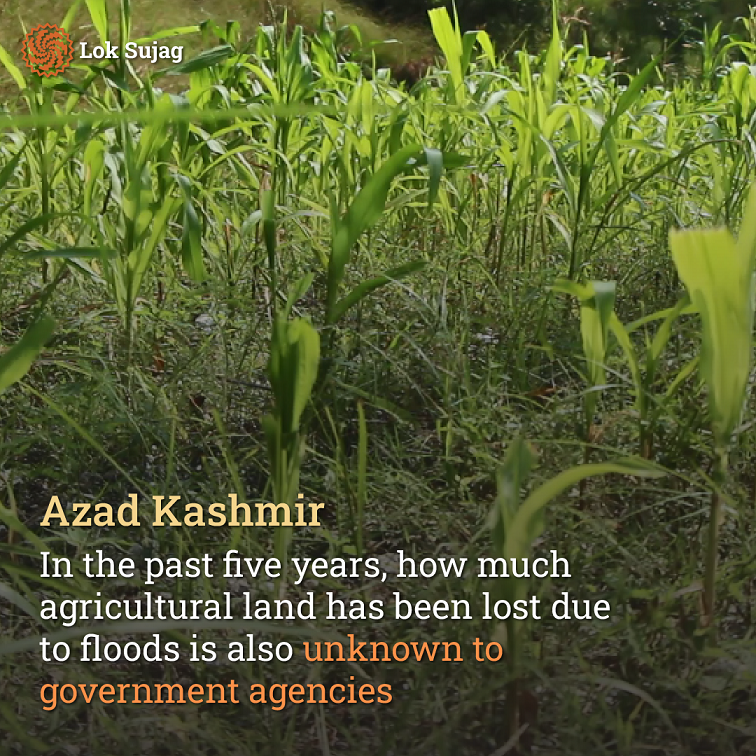
When information was sought from the former Research Officer of the Agriculture Department, Shafiq ur Rehman, he mentioned that due to climatic changes, there has been a noticeable reduction in crop, fruit, and vegetable yields in Azad Kashmir as well. The timing of crop cultivation has also changed, leading to alterations in the quality and taste of crops and fruits.
“The most worrying aspect is that climatic changes have adversely affected the rainfall pattern. Rainfall is now excessive in some areas and deficient in others. In the Neelum Valley, Leepa Valley, Bagh, Haveli, Kotli, and Bhimber, there used to be a specific rainfall pattern and agricultural activities were carried out at specific times. However, agricultural activities have been disrupted due to changes in rainfall timings.”
He says that these changes have increased the diseases in fruits and crops and led to a rise in the population of new insects, including locusts, fruit flies, and various types of worms.
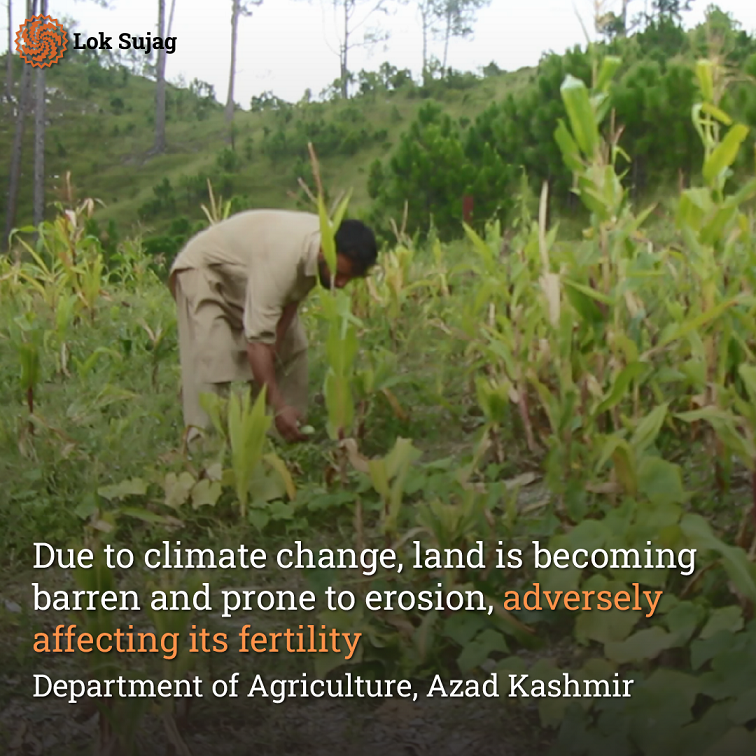
Shafiq ur Rehman further explained that land is becoming barren and prone to erosion due to climate change, while its fertility is also adversely affected. Naturally, plants found on mountain tops use this fertility at lower temperatures, but as temperatures rise, this fertility starts diminishing.
Zafar Jahangir works as a Research Officer in the Agriculture Department. When asked about efforts to protect crops from the effects of climatic changes, he mentioned that research is ongoing regarding maize and wheat crops, as well as on vegetables and fruits. Efforts are being made to introduce new seeds so that yields can increase, and farmers are also being guided in the selection of crops.
“We have seen a significant increase in fruit fly infestations in our region. Previously, these flies were limited due to lower temperatures, but that is no longer true. Similarly, there were no signs of wild boars in this area, but due to climate change, their population has increased, and even the small number of crops here is being destroyed by them.”
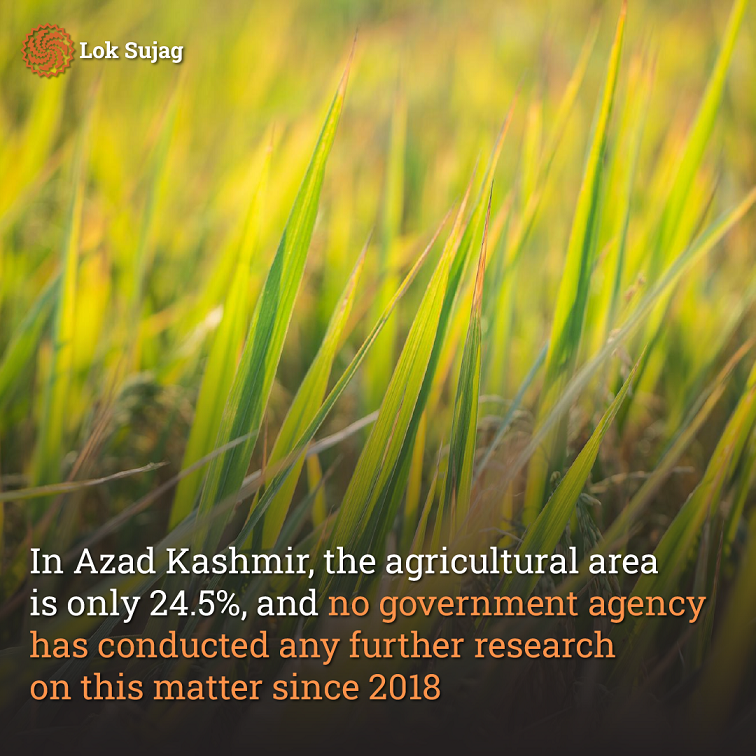
When asked about the percentage of agricultural land affected and the impact on yields over the past five years, he stated that he has no data on this matter.
Contact was made with the Secretary of Agriculture, Sardar Javaid Ayub, to obtain this information, but he did not respond. On the other hand, Azeem Khan, the Director of the Agriculture Department, mentioned that the department currently does not have any relevant data.
According to a report from the Environmental Protection Agency in 2018, environmental conditions in Azad Kashmir are causing a decrease in agricultural land due to the construction of new houses and a growing population. This is why the agricultural area in Azad Kashmir is only 24.5, and no government agency has conducted further research on this matter since 2018.
Also Read
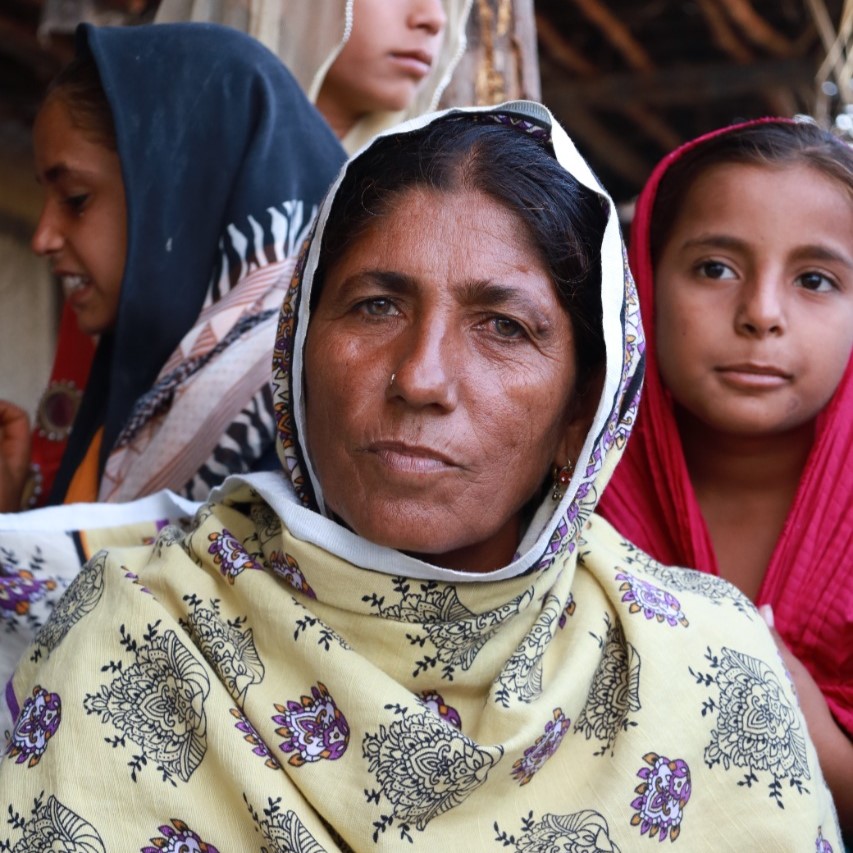
From fighting feudalism to braving climate disasters
Dr. Sardar Rafique, the Director of the Climate Change Cell, states that climate change is a significant challenge for agriculture in Pakistan-administered Kashmir.
“The agricultural area in Azad Kashmir has shrunk, and various crops have failed. In Neelum Valley, Shounter and Gurez Valley, people’s lives used to depend on crops; however, now they only hear stories about those crops.”
“Five years ago, a specific type of potato weighing up to two kilograms used to be grown in Neelum Valley, but it has now disappeared. Similarly, during winters, when roads were blocked due to rainfall and snowfall, people used to rely on Roti (bread) made from Tunbaha, but now it is no longer available. The fundamental reason behind this is the increase in temperature.
Sardar Rafique explained that the spring season has ended due to climate change, and summer now begins immediately after winter. In the past fifty years, there has been an average increase of 2 degrees Celsius in temperature, and there is a concern of an additional three-degree increase in the next fifty years. He stated that it may be possible to mitigate the future risks of food scarcity by considering changing weather conditions and adapting agriculture accordingly.
Published on 21 Sep 2023
